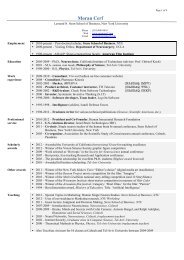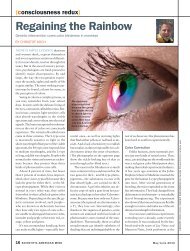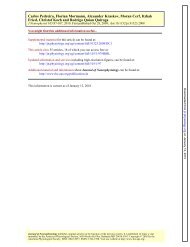When Does Consciousness Arise? - The Koch Lab
When Does Consciousness Arise? - The Koch Lab
When Does Consciousness Arise? - The Koch Lab
Create successful ePaper yourself
Turn your PDF publications into a flip-book with our unique Google optimized e-Paper software.
(consciousness redux)<br />
<strong>When</strong> <strong>Does</strong><br />
<strong>Consciousness</strong> <strong>Arise</strong>?<br />
In the womb, at birth or during early childhood?<br />
By Christof KoCh<br />
Mothers will want to crucify me for<br />
this seemingly cruel question, but it<br />
needs to be posed: How do we know that<br />
a newly born and healthy infant is conscious?<br />
<strong>The</strong>re is no question that the<br />
baby is awake. Its eyes are wide open, it<br />
wriggles and grimaces, and, most important,<br />
it cries. But all that is not the same<br />
as being conscious, of experiencing pain,<br />
seeing red or smelling Mom’s milk.<br />
It is well recognized that infants have<br />
no awareness of their own state, emotions<br />
and motivations. Even older children<br />
who can speak have very limited insight<br />
into their own actions. Anybody<br />
who has raised a boy is familiar with the<br />
blank look on your teenager’s face when<br />
you ask him why he did something particularly<br />
rash. A shrug and “I dunno—it<br />
seemed like a good idea at the time” is<br />
the most you’ll hear.<br />
Although a newborn lacks self-awareness,<br />
the baby processes complex visual<br />
stimuli and attends to sounds and sights in<br />
its world, preferentially looking at faces.<br />
<strong>The</strong> infant’s visual acuity permits it to see<br />
only blobs, but the basic thalamo-cortical<br />
circuitry necessary to support simple visual<br />
and other conscious percepts is in place.<br />
And linguistic capacities in babies are<br />
shaped by the environment they grow up<br />
in. Exposure to maternal speech sounds in<br />
the muffled confines of the womb enables<br />
the fetus to pick up statistical regularities<br />
so that the newborn can distinguish its<br />
mother’s voice and even her language from<br />
others. A more complex behavior is imitation:<br />
if Dad sticks out his tongue and waggles<br />
it, the infant mimics his gesture by<br />
combining visual information with proprioceptive<br />
feedback from its own movements.<br />
It is therefore likely that the baby<br />
has some basic level of unreflective, present-oriented<br />
consciousness.<br />
<strong>When</strong> did<br />
that newborn<br />
become consciously<br />
aware?<br />
the road to awareness<br />
But when does the magical journey of<br />
consciousness begin? <strong>Consciousness</strong> requires<br />
a sophisticated network of highly<br />
interconnected components, nerve cells.<br />
Its physical substrate, the thalamo-cortical<br />
complex that provides consciousness<br />
with its highly elaborate content,<br />
begins to be in place between the 24th<br />
and 28th week of gestation. Roughly<br />
two months later synchrony of the electroencephalographic<br />
(EEG) rhythm<br />
across both cortical hemispheres signals<br />
the onset of global neuronal integration.<br />
Thus, many of the circuit elements necessary<br />
for consciousness are in place by<br />
the third trimester. By this time, preterm<br />
infants can survive outside the womb<br />
under proper medical care. And as it is<br />
so much easier to observe and interact<br />
with a preterm baby than with a fetus of<br />
the same gestational age in the womb,<br />
the fetus is often considered to be like a<br />
preterm baby, like an unborn newborn.<br />
20 scientific american mind september/October 2009<br />
cOrBis
Used WitH PermissiOn Of ann ‐ sOfi GUstafs sOn and HUGO L aGercrant z<br />
( suspended in a warm and dark cave, connected to )<br />
the placenta, the fetus is asleep.<br />
But this notion disregards the unique<br />
uterine environment: suspended in a<br />
warm and dark cave, connected to the<br />
placenta that pumps blood, nutrients<br />
and hormones into its growing body and<br />
brain, the fetus is asleep.<br />
Invasive experiments in rat and lamb<br />
pups and observational studies using ultrasound<br />
and electrical recordings in humans<br />
show that the third-trimester fetus<br />
is almost always in one of two sleep<br />
states. Called active and quiet sleep,<br />
these states can be distinguished using<br />
electroencephalography. <strong>The</strong>ir different<br />
EEG signatures go hand in hand with<br />
distinct behaviors: breathing, swallowing,<br />
licking, and moving the eyes but no<br />
large-scale body movements in active<br />
a two-week-old preterm infant born in the 25th<br />
gestational week. although the newborn may already<br />
have some conscious experiences, a fetus of the<br />
same gestational age is kept actively sedated by<br />
the intrauterine environment.<br />
sleep; no breathing, no eye movements<br />
and tonic muscle activity in quiet sleep.<br />
<strong>The</strong>se stages correspond to rapid-eyemovement<br />
(REM) and slow-wave sleep<br />
common to all mammals. In late gestation<br />
the fetus is in one of these two sleep<br />
states 95 percent of the time, separated<br />
by brief transitions.<br />
What is fascinating is the discovery<br />
that the fetus is actively sedated by the<br />
low oxygen pressure (equivalent to that<br />
at the top of Mount Everest), the warm<br />
and cushioned uterine environment and<br />
a range of neuroinhibitory and sleep-inducing<br />
substances produced by the placenta<br />
and the fetus itself: adenosine; two<br />
steroidal anesthetics, allopregnanolone<br />
and pregnanolone; one potent hormone,<br />
prostaglandin D2; and others. <strong>The</strong> role<br />
of the placenta in maintaining sedation<br />
is revealed when the umbilical cord is<br />
closed off while keeping the fetus adequately<br />
supplied with oxygen. <strong>The</strong> lamb<br />
embryo now moves and breathes continuously.<br />
From all this evidence, neonatologists<br />
conclude that the fetus is asleep<br />
while its brain matures.<br />
dreamless sleep?<br />
One complication ensues. <strong>When</strong><br />
people awaken during REM<br />
sleep, they often report vivid<br />
dreams with extensive narratives.<br />
Although consciousness<br />
during dreams is not the same<br />
as during wakefulness—most<br />
noticeably insight and self-reflection<br />
are absent—dreams are<br />
consciously experienced and<br />
felt. So does the fetus dream<br />
when in REM sleep? This is<br />
not known. But what would it<br />
dream of?<br />
After birth, dream content is<br />
informed by recent and more<br />
remote memories. Longitudinal<br />
studies of dreaming in children<br />
by retired American psychologist<br />
David Foulkes suggest that<br />
dreaming is a gradual cognitive development<br />
that is tightly linked to the capacity<br />
to imagine things visually and to<br />
(Further Reading)<br />
visuospatial skills. Thus, preschoolers’<br />
dreams are often static and plain, with<br />
no characters that move or act, hardly<br />
any feelings and no memories. What<br />
would dreaming be like for an organism<br />
that spends its time suspended in a sort<br />
of isolation tank, with no memories,<br />
and no way to imagine anything at<br />
all? I wager that the fetus experiences<br />
nothing in utero; that it feels the way<br />
we do when we are in a deep, dreamless<br />
sleep.<br />
<strong>The</strong> dramatic events attending delivery<br />
by natural (vaginal) means cause the<br />
brain to abruptly wake up, however.<br />
<strong>The</strong> fetus is forced from its paradisic existence<br />
in the protected, aqueous and<br />
warm womb into a hostile, aerial and<br />
cold world that assaults its senses with<br />
utterly foreign sounds, smells and sights,<br />
a highly stressful event.<br />
As Hugo Lagercrantz, a pediatrician<br />
at the Karolinska Institute in Stockholm,<br />
discovered two decades ago, a<br />
massive surge of norepinephrine—more<br />
powerful than during any skydive or exposed<br />
climb the fetus may undertake in<br />
its adult life—as well as the release from<br />
anesthesia and sedation that occurs<br />
when the fetus disconnects from the<br />
maternal placenta, arouses the baby so<br />
that it can deal with its new circumstances.<br />
It draws its first breath, wakes<br />
up and begins to experience life. M<br />
Christof KoCh is Lois and Victor troendle<br />
Professor of Cognitive and Behavioral Biology<br />
at the California institute of tech nology.<br />
he serves on Scientific American Mind’s board<br />
of advisers.<br />
◆ <strong>The</strong> “Stress” of Being Born. Hugo Lagercrantz and theodore a. slotkin in Scientific<br />
American, Vol. 254, no. 4, pages 100–107 (92–102); april 1986.<br />
◆ <strong>The</strong> Importance of “Awareness” for Understanding Fetal Pain. david J. mellor,<br />
tamara J. diesch, alistair J. Gunn and Laura Bennet in Brain Research Reviews, Vol. 49,<br />
no. 3, pages 455–471; november 2005.<br />
◆ <strong>The</strong> Emergence of Human <strong>Consciousness</strong>: From Fetal to Neonatal Life. Hugo Lagercrantz<br />
and Jean-Pierre changeux in Pediatric Research, Vol. 65, no. 3, pages 255–260;<br />
march 2009.<br />
www.scientificamerican.com/mind scientific american mind 21






